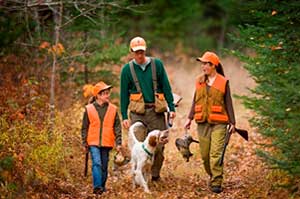- Details
(Provided by Michigan DNR)
The Michigan DNR's survey crews from the Charlevoix Fisheries Research Station headed out on Lake Michigan Aug. 24 to conduct surveys of yellow perch populations and other nearshore fish species. The surveys are being conducted from the research vessel Steelhead, as well as from smaller DNR vessels that permit sampling in shallow, nearshore waters. The surveys will run through September 11.
The DNR has been involved since 1995 in a lakewide collaboration with other Lake Michigan natural resources agencies to assess yellow perch. Data collected during these surveys is used to estimate a broad range of biological variables vital to understanding yellow perch populations in Lake Michigan and associated tributaries.
"Early indications from work in southern Lake Michigan by our sister agencies are that 2015 may be a banner year for yellow perch spawning and survival of young fish, so we're excited to get out and see what populations look like in Michigan waters," said Dave Clapp, Charlevoix Fisheries Research Station manager. "Fish hatched in 2010 and 2011 are just now reaching full maturity, so we expect to see an increase in spawning activity and an abundance of young perch this year, supported by increased lake levels and slightly warmer water temperatures this summer."
Survey operations will be conducted near the ports of South Haven, Grand Haven, Portage, Pentwater, Charlevoix and Petoskey. Vessels involved in the surveys will be docked at these Great Lakes ports, and the public is encouraged to visit the vessels and talk with crew members about fisheries assessment operations.
- Details
(Provided by Michigan DNR)
 Michigan releases its small game hunting outlook.Small game hunting season begins Sept. 1 with the opening of the early Canada goose season and teal seasons and continues until rabbit and hare season ends March 31. Michigan DNR wildlife biologists across the state say hunters should find conditions similar to last year. Hunters are reminded that due to changes in licensing, all licensed hunters may pursue small game.
Michigan releases its small game hunting outlook.Small game hunting season begins Sept. 1 with the opening of the early Canada goose season and teal seasons and continues until rabbit and hare season ends March 31. Michigan DNR wildlife biologists across the state say hunters should find conditions similar to last year. Hunters are reminded that due to changes in licensing, all licensed hunters may pursue small game.
Rabbits
Season: Cottontail rabbits and varying (or snowshoe) hare can be hunted from Sept. 15-March 31 Hunter with dog statewide. The daily bag limit is five in combination with a possession limit of 10.
Outlook: Roughly 56,000 hunters reported pursuing rabbits in 2011 (the most recently completed harvest survey) and about 12,000 hunted hares. Cottontail populations are good throughout their range over much of the state. Concentrate on thick cover, such as briar patches and brush piles, often near agricultural fields. Snowshoe hare populations are down from historic levels. Look for early-successional forests (such as aspen stands) and low-lying conifer swamps with blow-downs and brush piles in the northern two-thirds of the state.
- Details
 Mark ZonaArea anglers will have a chance to enjoy breakfast with four of the nations top bass fishing celebrities Aug. 22.
Mark ZonaArea anglers will have a chance to enjoy breakfast with four of the nations top bass fishing celebrities Aug. 22.
Kevin VanDam, Greg Hackney, Davy Hite and Mark Zona will appear that morning at the St. Joseph County Fairgrounds in Centerville, Mich. during a pancake breakfast to benefit the United Way.
All four anglers will be available between 8:30 and 10 a.m. for personal photographs and autographs. Admission is $5 per person and includes the pancake breakfast.
Zona and his wife Karin are Honorary Chairmen of the St. Joseph County United Way campaign.
- Details
The Michigan DNR has found a third free-ranging deer in Meridian Township (Ingham County) has tested positive for chronic wasting disease (CWD). The deer was a 5-year-old doe. All three CWD-positive deer detected thus far have been discovered within a mile of one another.
"As we stated with the second positive deer this news is not surprising," said Dr. Steve Schmitt, DNR wildlife veterinarian. "The good news is that all three deer came from the same small area.î Genetic analyses carried out by Michigan State University's Molecular Ecology Laboratory indicate that all three positive animals were related as part of an extended family. Previous research has shown that CWD often is transmitted within family groups because of their close contact.
- Details
(Provided by Michigan DNR)
The Michigan DNR has confirmed a second free-ranging deer in Meridian Township (Ingham County) has tested positive for chronic wasting disease (CWD), a fatal neurological disease that affects white-tailed deer, mule deer, elk and moose.
This second case is a 2-year-old male found less than a mile from the initial positive female deer, confirmed this past May. Genetic testing is being conducted to see if the two deer are related.
"Finding this second positive deer is disappointing, however, not unexpected," said DNR Wildlife Division Chief Russ Mason. "We will continue with our aggressive surveillance throughout the summer and fall. With the assistance of hunters, we hope to determine the distribution of this disease."
To date, 304 deer have been tested in the Core CWD Area. Only two have tested positive for CWD.


